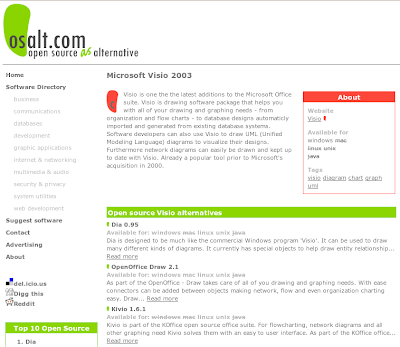VMware Announces Ultimate Virtual Appliance Challenge Winners
Sadly, I did not win a prize, nor did I receive an honorable mention. As a consolation prize, my ego is comforted by the fact that NeDiVA was downloaded more than 600 times. Thank you, bittorrent.
This announcement was not all bad news, since I discovered some very interesting virtual appliances. The following list of winners can also been found on the VMware website.
First Prize ($100,000)
HowNetWorks, a high-level network analyzer. (Mikko Hiltunen, Erno Kuusela, Joachim Viide, Mika Seppänen, Jani Kenttälä; University of Oulu, Finland)
The HowNetWorks virtual appliance is a network analyzer that works at a higher level than more traditional network analyzers like tcpdump or ethereal. Packaged inside a VMware virtual machine on top of Ubuntu, this virtual appliance contains a completely new application written by the author and comes with full documentation to get you started (with videos)!
Second Prize ($50,000)
Trellis NAS Bridge, network attached storage (NAS) virtualization for multiple CIFS/SMB and Unix/SSH servers. (Andrew Macdonell, Michael Closson, Paul Nalos, Paul Lu; University of Alberta, Canada)
The Trellis NAS Bridge Appliance is an appliance that makes it easier to access files from one location (i.e., a client) even though the files may be stored on different computers, different file servers, and different operating systems. The servers might also be under the control of different systems administrators. With the Trellis NAS Bridge Appliance, files can be accessed by applications and interactively as if they were local files.
Third Prize ($25,000)
Sieve Firewall, Transparent bridging iptables firewall configured through Windows-based .net GUI. (Michael C. Jett, Kennieth A. Goodwin; Missouri & Arkansas, USA)
At its simplest, Sieve is a virtual machine that runs an extremely small Linux kernel to create a transparent bridging firewall. However, it provides several unique features critical to an ongoing environment and/or tailored to the theme of the contest. Transparent bridging firewalls are not a new concept. Sieve uses the concept to provide an unprecedented feature set to a Windows OS user, including powerful and flexible iptables firewalling and netfilter traffic control.
Collegiate Category Prize ($5,000)
Open Network Registrar, a drop-in administration tool for BIND and DHCP. (Zachary Colgan; New York, USA)
Open Network Registrar provides a web-based administration front-end for BIND and DHCP, making it easier for administrators to integrate the functionality of the two systems. This virtual appliance uses the Apache web server with PHP to serve the web management interface for the system. Under the covers, this appliance uses ISC BIND for DNS and the standard DHCP daemon for DHCP services. A MySQL database is used to store configuration data and Perl is used for background applications.
Consumer Category Prize ($5,000)
FreeNAS, a network attached storage (NAS) server. (Olivier Cochard; Paris, France)
FreeNAS is a small (less than 16MB) Operating System based on FreeBSD 6.1 that provides network-attached storage services (CIFS, FTP, NFS, SSH, SCP, RSYNC, AFP). The configuration of this appliance is done from a web management interface.
Developer Category Prize ($5,000)
eBrainPool, a new dimension network of virtualized hosts sharing software, operating environment and computing platform. (Jatin Golani; Mumbai, India)
Software developers can use eBrainPool to carry their core set of programming language compilers, tools, libraries, operating system -- indeed their entire working setup -- in a flexible mobile manner. They can use eBrainPool to program in the same configuration at their work place and at home. Additionally, they can use the eBrainPool Client Application to search for other peer virtual machine environments that might meet the needs of a particular project. If they find an environment that meets their needs, they can use the eBrainPool client application to access the shared environment.
Server Category Prize ($5,000)
Enterprise Encryption Server, automated OpenPGP based data encryption/decryption. (Carl Bourne; UK)
The Enterprise Encryption Server provides an easy to deploy and manage centralized OpenPGP compatible encryption resource. This appliance can be deployed in minutes using VMware Player or Server. Files that are copied to the appliance via FTP or Windows file sharing (SMB) are automatically encrypted/decrypted and then copied to remote destinations. For compliance reasons every step of the process is logged.
VMTN Community Choice Prize ($5,000)
Hermes Memcached Virtual Appliance, a high-performance distributed memory object caching system using memcached. (Prabhakar Chaganti; Georgia, USA)
Hermes is a virtual appliance that provides a high-performance, distributed memory object caching system by using the popular memcached project. The cache itself is generic and can be utilized for any caching needs, but it is most often used to speed up dynamic web applications by easing the database load. You start up the virtual appliance and it starts up a memcached daemon waiting to serve requests. The default memcache daemon's parameters are printed in a message on the screen after startup. You can login and change the parameters if you want to change any of the options. It runs on a Linux OS built from scratch to have a minimal footprint. Almost all of the memory that you assign to the virtual appliance can be utilized by the memcached daemon! Hermes also provides a built in ssh server and dhcp client. You can administer the machine remotely via ssh.


Comments
Post a Comment